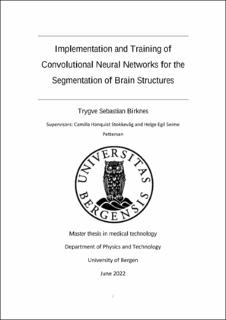Implementation and Training of Convolutional Neural Networks for the Segmentation of Brain Structures
Master thesis
Permanent lenke
https://hdl.handle.net/11250/3000141Utgivelsesdato
2022-06-01Metadata
Vis full innførselSamlinger
- Master theses [93]
Sammendrag
Precise delivery of radiotherapy depends on accurate segmentation of the anatomical structures surrounding the cancer tissue. With increasing knowledge of radio-sensitivity of critical brain structures, more detailed contouring of a range of structures is required. Manual segmentation is time-consuming, and research into methods for auto segmentation has advanced in the past decade. This thesis presents a general-purpose convolutional neural network with the U-net architecture for auto-segmenting the brain, brainstem, Papez Circuit, and right hippocampus. Several different models were trained using T1 MRI, T2 MRI, and CT images to compare the performance of models trained with the different modalities. Low-level preprocessing was done to the images before training, and the Dice score measured model performance. The best performing model for segmentation of the full brain resulted in a Dice score of 0.98, whereas the segmentation of the brainstem achieved a Dice score of 0.73. Furthermore, segmentation of the complex structure Papez Circuit attained Dice score of 0.52, and segmentation of the hippocampus resulted in a Dice score of 0.49. The selected model performed well in segmentation of the full brain and decent for the brainstem compared to similar studies. In contrast, the segmentation results for the hippocampus were slightly lower than previously reported results. No comparison was found for the segmentation results of the Papez Circuit. More preprocessing and patient data is necessary to provide accurate segmentation of the smaller structures. The dataset presented a few problems, and it was discovered that a similar acquisition method for image sequences gives better results. The network architecture provides a solid framework for segmentation.
